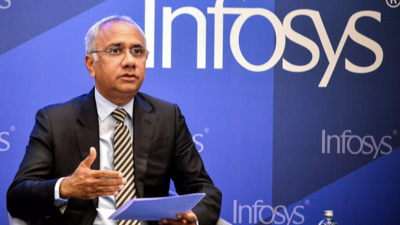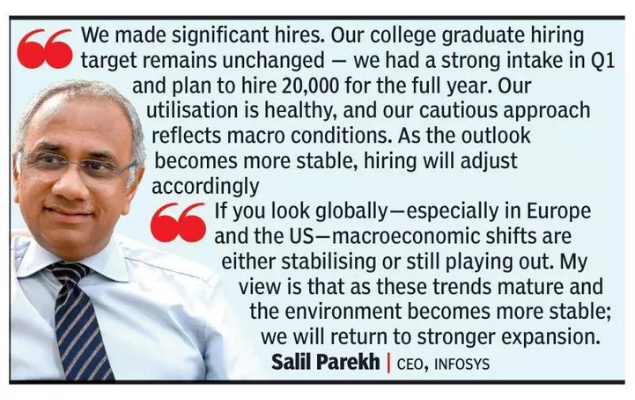TCS layoffs rattle IT sector: Infosys rules out job cuts; focuses on freshers and AI reskilling | Bengaluru News

BENGALURU: TCS‘s recent decision to lay off over 12,200 employees (its biggest job cuts) sparked concern across the IT industry, raising questions about workforce stability and future hiring. In contrast, Infosys CEO Salil Parekh offered a measured response, explaining how the company managed to stay slightly ahead by making strategic investments in AI and reskilling its workforce. Infosys said it is sticking to its target of hiring 20,000 freshers. The company also raised the lower end of the guidance from 0% to 1%, setting a new range of 1% to 3% in constant currency for FY26.TCS is laying off 12,000 people. Nasscom indicated the shift might trigger rationalisation. Is Infosys planning job cuts? We recruited over 17,000 people (gross hiring) in the first quarter and plan to bring in about 20,000 college graduates this year. Our focus remains firmly on reskilling, particularly in AI, where we’ve already trained over 275,000 employees at various levels. This reskilling effort opens significant opportunities for our workforce as we see growth in AI, cloud, and enterprise platforms. We’ve been deeply focused on AI transformation — whether it’s building AI agents or developing smaller language models internally. Beyond technology, we are also benefiting from strategic client decisions around partner consolidation. We believe this will generate substantial opportunities for employees as they get reskilled — like what we achieved during digital transformation. The ability to learn and adapt continues to be crucial in today’s fast-evolving market. Data and cloud are the foundational layers that make AI implementation effective, and our strong cloud services practice enables us to deploy more people across programs.The industry is undergoing a structural reset. How important is reinvestment versus focus on margins?It’s critical to invest. We made significant investments in digital and AI, building agents and language models, and reskilling employees. We also focused on internal efficiency to support these investments without major disruptions. This approach allows us to put more people on new projects.Infosys posted low single-digit growth for three consecutive years. Is this the new normal for the IT industry?If you look globally — especially in Europe and the US — macroeconomic shifts are either stabilising or still playing out. My view is that as these trends mature and the environment becomes more stable, we will return to stronger expansion. Technology’s centrality is growing across sectors. New opportunities continue to emerge in cloud, data, and technology-driven process transformation. While productivity is one theme, the broader trend is expansion. For this year, our 1–3% growth guidance reflects how client demand evolves. As the environment improves, we expect corresponding changes within Infosys.With AI reshaping Indian IT, are traditional models like pyramid and bench becoming obsolete? Are metrics like net hiring and utilisation losing relevance as lead indicators of growth?

There are clear changes in the business model, but they also open new opportunities. AI allows for deeper automation and insights but also demands higher-level skills and more effort. Our headcount continues to grow, reflecting our sustained investment in people and technology. Our utilisation model hasn’t changed — we ensure optimal alignment between project needs and available talent. With fresh graduates, our training-to-deployment approach remains intact.How do you ensure the human-in-the-loop remains relevant despite low to medium intensity coding being automated? We’re seeing 5% to 15% productivity gains in software development through AI and automation, and even more in customer service and knowledge tasks. But human involvement remains central, especially in complex, integrated systems. Take Infosys Finacle—our banking platform delivers around 20% productivity improvement by blending automation with human oversight. When working with clients—typically large enterprises with multiple systems and sometimes companies brought together through acquisitions—we see significant benefits of 5% to 15% in software development. These are based on real client implementations.Given that Infosys has not yet decided on the next round of wage hikes, how are you approaching this amid current market conditions?We concluded our compensation increases for Q4 and Q1 of the last fiscal year. The process remains comprehensive and applies across levels. We will continue with this approach. Now that this cycle is complete, we are beginning to evaluate the timing for the next round—as we do after every cycle. During COVID, the standard cycle was disrupted, leading to two increases over 18 months. There are no changes planned. We will stick with our existing process and announce the next cycle at the right time.Infosys had a net addition of just 210 people in Q1.We made significant hires. Our college graduate hiring target remains unchanged — we had a strong intake in Q1 and plan to hire 20,000 for the full year. Our utilisation is healthy, and our cautious approach reflects macro conditions. As the outlook becomes more stable, hiring will adjust accordingly.How is Infosys engaging with GCCs as their models evolve?We bring deep institutional knowledge and work closely with clients to scale GCC operations, implement AI, and roll out next-gen technologies. In many GCCs, we’re driving major transformation—integrating tech stacks and supporting enterprise-wide change. We’ve also centralised our GCC engagement, ensuring each vertical maintains direct collaboration. We share insights—from global scaling to building AI agents and launching SaaS or public cloud solutions. Some clients need more tailored models, and we’ve delivered customised engineering and tech services to meet those unique needs.Licensing revenue makes up 7%–8% of total revenue, suggesting the core business is underperforming without it.In Q1, third-party revenue declined sharply. In some engagements, we manage full transformations, including software, hardware, and services—end-to-end. These require close involvement, making it hard to separate roles. Where possible, we take a support-only role. Now that we’re more selective, we only participate in such full-scope engagements when necessary. We expect third-party revenue to stay subdued this year, as we pursue such work only at the client’s specific request.




